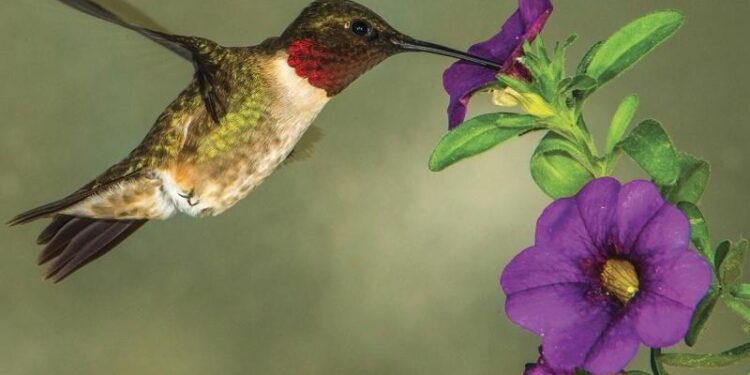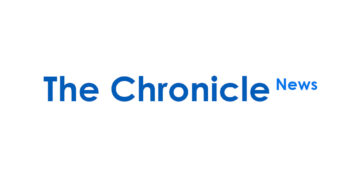I probably get more questions about hummingbirds than any other non-game creature. I was talking to a couple of folks the other evening about the different types of little nectar eaters we have in this part of the state.
Reports on the Oklahoma Bird Watchers Facebook page indicate a few early arrivers are scouting around for food sources, so it’s time to get the feeders all cleaned and filled up.
There are several different species of hummingbirds, but only two or three will be found in Oklahoma.
“The two most common species are ruby-throated and black-chinned,” Said Mark Howery, with the Oklahoma Department of Wildlife Conservation. “Both very colorful and very playful little birds. Although these two species are the most common, there are other species that venture our way every once in a while. Reports of a broad-tailed or rufous hummingbird showing up at someone’s feeder gets passed along every once in a while.”
The next question people always ask is how to attract more hummingbirds to their backyard. For that question I refer to an organization called the hummingbird society. They have a great website with lots of good information for attracting hummingbirds. Some of the suggestions that the group makes are: honeysuckle, hibiscus, salvia, sage, morning glory, bee balm, phlox and cannas — or go to their website at www.hummingbirdsociety.org. Not only do these plant attract hummingbirds, but also bees, moths and other nectar eaters.
Flowers are the natural way to attract hummingbirds to your yard. However, for many people a flower garden is not an option: no space for a garden; no time to tend it; and perhaps no skill or interest in the garden approach. If you are one of these people, then man-made feeders filled with a mixture of water and ordinary table sugar (sucrose) are an important alternative. Even for those with gardens, feeders provide a supplement to flowers that increases the likelihood of attracting hummingbirds.
Sugar, whether from a flower or a feeder, is essential for a hummingbird’s diet. It provides the quick fuel for flight that it needs during waking hours; it is not “junk food.” (Human metabolism is not comparable to hummingbird metabolism!) Hummingbirds rely on insects and tiny spiders to provide protein for their diet, since neither flowers not sugar-water mixtures will provide it.
“We recommend that people start placing feeders out the middle of April, unless they see birds before that,” added Howery. “Feeders can be kept out until late October.” A good rule of thumb is to put feeders out at tax time and take them down at Halloween.
Tests have shown that hummingbirds prefer sucrose in flower nectar over other sugars such as fructose and glucose, so your feeder, with the proper ratio of ingredients, becomes a good approximation to the flowers hummers like best.
Formula–4 parts water to 1 part sugar. The water should not be distilled. The sugar should be white table sugar, not turbinado sugar, brown sugar, or other forms. Use no artificial colors (red dye does not help attract hummingbirds) or other additives. Never use honey or artificial sweeteners, which may kill the birds.
Preparation–The ingredients can be mixed using cold water. Experience has shown that mixtures do not go bad as quickly if the water is boiled, and the sugar added to it. Do not continue to boil the mixture, as it will turn to syrup. Unused portions of a mixture can be stored in the refrigerator for up to a week.
Feeder Design–The most important consideration in choosing a feeder is your ability and personal willingness to keep it clean, because feeders vary widely in their ease of cleaning. Feeders with parts that cannot be easily cleaned should be avoided. Some designs can be disassembled and washed in a dishwasher, a convenience but not a necessity.
Most all designs work, but some “vacuum” designs cause a dripping problem which will inevitably attract ants. Perches on the feeder are optional, but should be removable if being used when temperatures are at or below freezing. Feeders also vary widely in their attractiveness, from the beautiful to the ugly; be sure you want to look at the design every day!
Feeder Maintenance–Any mixture of sugar and water will ferment and host the growth of mold spores. This limits the usefulness of the mixture, and it must be discarded regularly to avoid these problems.
In moderate temperatures, such as 60-85 degrees F, a mixture should last about 3 days; less at higher temperatures, slightly longer at cooler temperatures. Regardless of the mixture’s age, discard it immediately if you see cloudiness or you see mold growing in the feeder.
Always clean a feeder thoroughly before refilling; do not “top off” a feeder which is low in mixture. Clean with warm water and detergent, and rinse very thoroughly. Use only as much mixture as is being used between refilling to reduce waste. Every few weeks, rinse the cleaned feeder with dilute (1:10) bleach, then rinse very thoroughly.
Feeder Pests-Ants, bees, wasps–and even bats–can be a problem. So here are a few tips to help with these annoying little creatures.
Ants can quickly contaminate a feeder solution and make the it very unattractive to hummingbirds. Fortunately, this problem is easily solved. The first and easiest technique, though not always the most effective, is to coat the hanging wire or pole with a spray (such as Pam) or oil. This takes advantage of ants’ aversion to walking on certain substances, including oils and water. One can also buy an “ant moat” at most bird supply stores. The conventional use of the moat is to insert it between feeder and hanging hook, and then fill it with water. In hot, dry climates, this may require frequent refilling.
Alternatively one can smear a coating of oil or grease on the inside moat surface and accomplish the same thing, with no need to refill regularly. Finally, an “ant trap” is commercially available which does an excellent job, being inserted between feeder and hanging hook like the ant moat. The ant trap is not really a trap; like the moat it relies on having an internal surface which ants will not walk across. Ant moats and ant traps are relatively inexpensive and very effective.
One can also construct a home-made ant moat by using the plastic cap from a spray can, punching a hole in it to allow it to slide on the hanging rod for the feeder, and smearing it with oil or grease.
Bees and Wasps are a more serious problem, because in addition to contaminating the homemade nectar in the feeder, bees and wasps can be very competitive and able to keep hummingbirds from feeding. There are also documented cases of hummingbirds being stung and even killed by the stings.
Commonly it is suggested that spraying the bee guards over the ports with Pam® or similar substance will keep bees and wasps away, but rarely is this technique effective, or at least not for long.
Want to reach a local audience and grow your business?
Our website is the perfect platform to connect with engaged readers in your local area.
Whether you're looking for banner ads, sponsored content, or custom promotions, we can tailor a package to meet your needs.
Contact us today to learn more about advertising opportunities!
CONTACT US NOW






